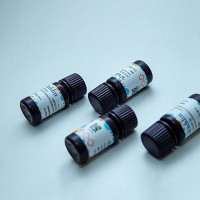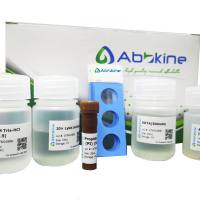Cloning of small RNAs with 5’ phosphate and 3’ OH ends
互联网
Introduction
The following protocol describes a procedure for the purification and cloning of miRNAs and other small RNAs in the 20-30 nucleotide size range from plant tissue. Figure 1 gives an overview of the cloning procedure.
Back to top
Procedure
Purifying 20-30 Nucleotide lengths from 10µg of Total RNA (1 µg/µl).
Instead of gel purification, mirVANA isolation can replace this step following manufacturer’s instructions. We have used from 1.5 to 5 µg of small RNA (from 10 to 35 µg total RNA). Note, we also use Arabidopsis floral tissue, which has a high percentage of small RNAs (comment 1).
-
Prepare the 15% 8M UREA gel. Pour a 15% UREA gel in the Biorad MiniProtean 2, using 0.75mm spacers.
12.5 ml makes two 0.75mm gels
- 5.25g Urea
- 625 µl 10X TBE
- 4.7 ml 40% acrylamide (19:1 acrylamide:bis-acrylamide)
- Add water to 12.5 ml and dissolve urea
- Add 87.5 µl 10% APS
- 4.4 µl TEMED
- Pour immediately (comment 2)
- Pre-run the gel for 30 min at 200V and then wash the wells using 0.5X TBE.
- Mix 10 µl (10 µg) of total RNA with 10 µl of 2x Gel Loading Buffer II (or equal volume 100% formamide with loading dye) in a 200 µl RNase-free microfuge tube. Heat the sample at 65°C for 5 min, then snap cool on ice. Centrifuge to collect volume to bottom of tube and load the sample into one well.
- Load 10µl of the Baulcombe oligo ladder already prepared (sizes marked 20, 30, 40, 60 and 80)
- Run the gel at 150V until the bromophenol blue reaches the bottom of the gel (about 2 hours). Stain the ladder portion of the gel with 0.5X EtBr for 2-5 min.
- Cut out the gel slice corresponding to 20-30 nt (visualized with UV) with a clean razor blade and transfer to a 0.5 ml RNase-free microfuge tube whose bottom has been punctured 3 to 4 times by a 21 gauge needle.
- Place this tube into a 2 ml RNase-free round-bottom microfuge tube and spin the gel through the holes into the 2 ml tube at full speed for 2 min (comment 3).
- Add 500µl of sterile 0.3 M NaCl to the tube and elute the RNA by rotating the tube overnight at 4°C.
- Transfer the eluate and the gel debris into a Spin-X Cellulose Acetate filter and spin at full speed for 2 minutes.
- Wash the gel bits once more with 100µl 0.3M NaCl and spin for another 2 min. Collect the 100µl eluate in the same tube.
- Add an equal volume (~600µl) of 100% Isopropanol and 3µl of glycogen (we used Ambion glycoblue) to the sample and incubate at �80°C for 20 to 30 minutes.
- Spin down at 14K rpm for 25 minutes in a 4°C microcentrifuge.
- Carefully remove supernatant and wash pellet with 750µl of room temperature 75% EtOH. Allow the RNA pellet to air dry then dissolve the RNA in total of 5.7µl of DEPC-treated water (we used Ambion’s nuclease-free water).
5’ Adaptor Ligation and Purification
- Heat the RNA for 30 seconds at 90°C and then snap cool on ice.
-
Set up the 5’Adaptor ligation reaction in a 1.5 ml RNase free silconized microfuge tube:
- Purified miRNA from step 1.12 5.7µl
- 5’ RNA adaptor (5 µM) 1.3µl
- 10X RNA ligation buffer 1µl
- T4 RNA ligase (10 U/µl) 1µl
- RNAguard™ (40 U/µl) 1µl
- Incubate at 37°C for 1 hour. (Or at +20°C for 6 hours then 4°C overnight in a PCR machine).
- Stop reaction by adding either 10µl 2x Gel Loading Buffer II or 10µl 100% formamide and 3µl loading dye. Heat the ligated sample/loading buffer mixture at 65°C for 5 minutes prior to loading gel.
- Prerun the 15% TBU gel (0.5X TBE 0.75mm Biorad Mini-Protean II gel) for 30 minutes at 200V. See recipe in step 1. Wash the wells with TBE buffer prior to loading.
- Load the ligated samples and the 40-60nt ladder (10µl of prepared ladder) in wells with at least 1 space in between ladder and samples. It is advisable to run each sample with its own ladder and cut the gel before staining OR run each sample on separate gels to avoid contamination amongst samples.
- Run gel at 150V until the xylene cyanol is near the bottom of the gel (about 2hours: the xylene cyanol runs at about 40nt on this gel). Stain the ladder portion of the gel OR each sample with its own ladder using 0.5X TBE/ EtBr.
- Cut out the gel band corresponding to 40-60 nt with a clean razor blade (after aligning the stained ladder back to the gel if ladder was cut away separately) and transfer the gel slice to a 0.5 ml RNase-free microfuge tube whose bottom has been punctured 3 to 4 times by a 21 gauge needle.
- Place this tube into a 2 ml Rnase-free round-bottom microtube and spin the gel through the hole into the 2 ml tube at full speed for 2 min.
- Add 500µl of sterile 0.3 M NaCl to the tube and elute the RNA by rotating the tube overnight at 4°C.
- Transfer the eluate and the gel debris into a Spin-X Cellulose Acetate filter and spin at full speed for 2 minutes.
- Wash the gel bits once more with 100µl 0.3M NaCl and spin for another 2 min. Collect the 100µl eluate in the same tube.
- Add an equal volume of 100% Isopropanol (~600µl) and 3µl of glycogen to the sample and incubate at �80°C for 20-30 minutes.
- Spin down at 14K rpm for 30 minutes in a 4°C microcentrifuge.
- Carefully remove supernatant and wash pellet with 750µl of room temperature 75% EtOH. Allow the RNA pellet to air dry then dissolve the RNA in total of 6.4µl of DEPC-treated water (we used Ambion’s nuclease-free water).
[1] [2] [3] 下一页







